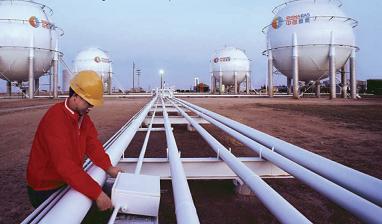
China Gas MD Liu Minghui
AMONG THE 14 companies highlighted at the recent Institutional Investor Conference 2009, co-sponsored by Aries Consulting, even a cursory look at the numbers reveals just why Taifook Research held the most bullish position on China Gas Holdings Ltd, giving the firm a 69% target price upside to its end-March valuation of 1.21 hkd.
For China’s economic regulators with hands on the purse strings of the recent 4.5 trln yuan stimulus package, the Hong Kong-listed (HK 384) clean energy and pipeline firm is one of the darlings of industry due to both its environmentally friendly alternative to heavily polluting coal as well as its strong employment contribution.
“For every two mln households we supply with natural gas, we must hire another 500 employees,” said Liu Minghui, Managing Director of China Gas, surely music to the ears of government officials intent on putting laid-off migrant workers back on payrolls.
China’s energy sector, tightly regulated and dominated by state-owned drillers and refiners, is clearly moving toward cleaner alternatives and away from overreliance on the burning of brown, or “dirty” coal with its heavy carbon footprint.
Coal provided 69.1% of China’s total energy needs in 2005, and is expected to fall to 66.1% next year. Meanwhile, over the same period natural gas should jump from 2.8% to 5.3%, or from 50 bln cubic meters to 120 bln.
In fact, demand is so far from being met that Mr. Liu said if China Gas had sufficient supplies, its sales would treble!
Solid Earnings, Liquid Strength
The company reported a 544% year-on-year leap in net profit in the half ending September 2008 to 417 mln hkd primarily due to a gain of 343 mln on the acquisition of units.
The liquefied natural gas (LNG) and liquefied petroleum gas (LPG) supplier, as well as investor and operator of the pipelines which deliver it all to homes, businesses and factories, saw a 138% spike in sales volume of LNG over the period.

China Gas' pipelines.
He said the company is putting most of its efforts into gas sales rather than pipeline projects because the former offered “recurring income” rather than a one-time gain.
Its H1 FY09 revenue was 63.0% sourced from sales of piped gas, up slightly from the 62.7% a year earlier.
But this did not mean that connection fees were being put on the back burner, as they still comprised a quarter of the firm’s revenue.
“Our Puguang project, brought online at the beginning of this year, will provide 13 bln cubic meters of annual capacity,” Mr. Liu said.
Following the company’s recent buyout of several subsidiaries, he said China Gas was planning to focus primarily on organic growth, beginning next year.
He also said that the company’s liquidity was quite healthy, and its recent buying spree was not funded at the expense of diluting share values.
“Since the start of 2006, we haven’t issued any new shares,” Mr. Liu said.
Looking forward, he said the firm expected four major revenue drivers:
1) new city supply contracts;
2) more residential clients;
3) boosting LPG business, and
4) long distance pipelines.
China Gas has two primary sources of revenue, namely connection fees: a one-off payment mainly from residential users, and less so from industrial/commercial users.
The second is from actual gas sales, which represents recurring income at tariffs approved by local governments.
“For each family we connect, this brings in an additional 2,200-3.300 yuan,” Mr. Liu said.
China Gas’ total issued shares of around 3.3 bln are 9.9% owned by Sinopec, 7.7% by Oman Oil, with 45.9% held by the public.
Related story: WINNERS after the crisis ...






